Kenneth L. Gentry Jr.'s Blog, page 32
November 4, 2022
DISPENSATIONALISM’S PROBLEM WITH REV 20
PMW 2022-083 by Kenneth L. Gentry, Jr. Dispensationalists are prone to boast that Revelation 20 presents their system in clear and certain terms. They often declare that they can go to one text of Scripture and find their system. Unfortunately, this is not the case. This text actually presents them with serious problems. Consider the following.
Dispensationalists are prone to boast that Revelation 20 presents their system in clear and certain terms. They often declare that they can go to one text of Scripture and find their system. Unfortunately, this is not the case. This text actually presents them with serious problems. Consider the following.
First, the concluding period of earth history, which experiences the glorious victory of Christ, is a thousand years long, but its length appears in only one chapter of the entire Bible.
Second, Christ’s thousand year rule not only appears in only one chapter in Scripture, but that chapter is in the Bible’s most symbolic book. This book has a seven-headed beast, a woman standing on the moon, fire-breathing prophets, and more.
Third, consistency requires that dispensationalists literally interpret the “key” to the abyss as a physical object (Rev 20:1). Yet the same book presents Christ as holding a “key” to death (Rev 1:18). Surely death does not have a literal key.
Fourth, if we interpret Revelation 20 literally then only those Christians who live during the beast’s time will enter the premillennialist’s millennium. This is because the text only states that those who are martyred under him and effectively resist him will rule (Rev 20:4). Even if dispensationalists place the beast toward the end of history, just prior to the Rapture, the problem remains: The text only speaks of those who are martyred under him.

Dispensational Distortions
Three Lectures by Kenneth Gentry. Reformed introduction to classic dispensationalism, with analysis of leading flaws regarding the Church, kingdom, redemptive history, and Christ. Helpful for demonstrating errors to dispensationalists.
See more study materials at: www.KennethGentry.com
Fifth, if Revelation 20 presents only two resurrections, a problem arises. For according to their system the first resurrection is of all the saints. Then the second resurrection is at the end of the millennium and involves only the lost. Consequently, there is no resurrection for converts who die during both the tribulation and in the millennium.
Sixth, their view of a millennium in which Christ personally rules the nations is terribly problematic. For it results in his second humiliation, wherein his kingdom turns against him and surrounds him in Jerusalem (Rev 20:8–9). And this despite his own personally ruling them with a rod of iron.
Seventh, the premillennial view presents an absurd situation. On this view mortals who are aware that immortal, resurrected saints have been ruling them for a thousand years will nevertheless revolt against those immortals in trying to defeat them. This does not make sense.
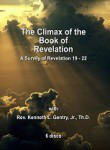 The Climax of the Book of Revelation (Rev 19-22)
The Climax of the Book of Revelation (Rev 19-22)
Six lectures on six DVDs that introduce Revelation as a whole, then focuses on its glorious conclusion. Provides an important, lengthy Introduction to Revelation also.
See more study materials at: www.KennethGentry.com
November 1, 2022
GRADUALISM IN ESCHATOLOGY
 PMW 2022-082 by Kenneth L. Gentry, Jr.
PMW 2022-082 by Kenneth L. Gentry, Jr.
Since Hal Lindsey originally burst on the scene in 1970, biblical prophecy has become a fun game that the whole family can play. Biblical prophecy has thus become a toy and has led many game winners (who have sold in excess of 100 million books to qualify) to be excitedly declared “Prophecy Experts.” But as for me and my house, once I hear the term “prophecy expert,” I turn the channel. Even if I do not have the TV on. I don’t take chances.
When I was first converted in 1966, I got caught up in prophecy rage, especially when The Late Great Planet Earth was published in 1970. I longed to watch new Olympic sports events, such as “Pin the Horns on the Antichrist” or “Guess the Date of Rapture.” Or even to see a new TV game show: “I’ve Got a Secret (Rapture). Eventually I even received a B.S. degree in Biblical Studies from a college committed to such dispensational activities. “Those were the days, my friend, / I thought they’d never end.” But fortunately I grew up and walked away from such. And have not looked back (though, admittedly, I like salt).
One of the most important principles for understanding biblical prophecy is known as the “Now but Not Yet Principle,” also known as the “Already/Not Yet Principle” (it is never called the “See You Later Alligator Principle” or “Take It Easy Greasy Principle”). If Christians would take this interpretive principle to heart (or better: to mind), a lot of embarrassment from failed prophetic expectations could be avoided. And a lot of money saved on books that give the latest Rapture predictions.
Before I state the Now/Not Yet Principle, I will note that it aligns nicely with the postmillennial principle of “Gradualism.” But what is this principle?
The Gradualism Principle
Gradualism (which is set over against Catastrophism) teaches that God generally works out his plan in history gradualistically (little-by-little, here-a-little-there-a-little) rather than catastrophically (all at once as a full-blown reality). We have many clear examples of gradualism found in familiar portions of Scripture.
For instance, an historical indicator of kingdom gradualism appears in the Promised Land’s conquest. In Deuteronomy 7:22 we read: “And the Lord your God will clear away these nations before you little by little; you will not be able to put an end to them quickly, lest the wild beasts grow too numerous for you.” Here Moses specifically informs Israel that though he has given her the promised land, the gradual conquest of the land is for her good. That is, it allows her to conquer in such a way that they could secure and maintain control of the land.
In Daniel 2:31–45 Christ’s kingdom appears as coming down to earth as a stone smiting the world kingdom. As we read through the passage we learn that the kingdom grows to become a great mountain in the earth: “You watched while a stone was cut out without hands, which struck the image on its feet of iron and clay, and broke them in pieces . . . . And the stone that struck the image became a great mountain and filled the whole earth. And in the days of these kings the God of heaven will set up a kingdom which shall never be destroyed; and the kingdom shall not be left to other people; it shall break in pieces and consume all these kingdoms, and it shall stand forever” (Da 2:34–35, 44). Thus, the stone gradually grows to become a “great mountain.”
In Ezekiel 17:22–24 God promises to establish the kingdom by establishing it as a small “sprig from the lofty top of the cedar.” Then he will nurture it until it becomes “a stately cedar.” It produces great boughs so that “birds of every kind will nest under it.” This growth is certain for “I am the LORD; I have spoken, and I will perform it.” We all know how trees grow: gradually over time, and very large over head.
In Ezekiel 47:1–9 redemption flows forth from God’s temple in stages. The waters of life initiate from under the altar, first to the ankles (v 3), then to the knees (v 4a), then to the loins (v 4b), then it “was a river that I could not ford” (v 5). This is the river of life (v 9). It gradually flows ever deeper.
In Matthew 13 the Kingdom Parables speak of the kingdom’s increase in size and gradual influence. Matthew 13:3–9 portrays the kingdom as scattered seed that gradually grows to bear abundant fruit. Matthew 13:31–33 speaks of its growth as that of a mustard seed, which gradually becomes a great plant, and as a little leaven that gradually leavens three bushels of meal. In Mark 4:26– 29, God’s kingdom begins as mere seed (v 26), then it puts forth the blade, then the head, the mature grain (v 27). Gradually, over time.
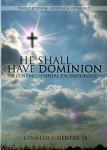
He Shall Have Dominion
(paperback by Kenneth Gentry)
A classic, thorough explanation and defense of postmillennialism (600+ pages). Complete with several chapters answering specific objections.
See more study materials at: www.KennethGentry.com
Thus, is the Gradualism Principle. But now what about the Now/Not Yet Principle?
The Now/Not Yet Principle
As noted above, the Now/Not Yet Principle coheres well with the Gradualism Principle. Basically the Now/Not Yet Principle teaches that certain prophetic expectations are stated in the NT as coming to pass in the first century. These prophetic fulfillments are spoken of in such a way that we would think it involved a good college basketball player who is “one and done” (he takes one year of college, and that is all of his college “career”).
Though certain prophetic issues are stated as coming to pass, the Now/Not Yet Principle requires that they follow the pattern of Karen Carpenter’s suggestion, “We Have Only Just Begun.” That is, the kingdom does come in the first century, but it is not present in its final, fullest expression. Also we read that Christ defeats his enemies at the cross, but that those enemies are not yet fully destroyed. And so forth.
For instance, we see the Now/Not Yet Principle at work when we read Heb. 2:8. Notice the bold statement that appears to declare the full subjugation of Christ’s enemies: “You have put all things in subjection under his feet” (Heb. 2:8a). But this is immediately followed by an historical observation that qualifies the statement: Heb. 2:8b adds: “For in subjecting all things to him, He left nothing that is not subject to him. But now we do not yet see all things subjected to him.”
Thus, the NT teaches that he has subjugated his enemies beneath his feet. But also that he has not! Paradoxically as it may sound, both are true — based on the Now/Not Yet Principle. To put it another way, he has legally effected subjugation of his enemies, but he has yet to historically effect their subjection (this is what postmillennialism strives toward).
Similarly, we have two parables of Christ regarding a wedding feast. And they appear contradictory. Unless we recognize the Now/Not Yet Principle. Let me explain.
Three Views on the Millennium and Beyond
(ed. by Darrell Bock)
Presents three views on the millennium: progressive dispensationalist, amillennialist, and reconstructionist postmillennialist viewpoints. Includes separate responses to each view. Ken Gentry provides the postmillennial contribution.
See more study materials at: www.KennethGentry.com
In Matt. 22:1–14 Jesus gives a parable that speaks of the wedding feast as a present reality. In fact, the negative point of the parable reads: “When the king came in to look over the dinner guests, he saw a man there who was not dressed in wedding clothes” (Matt. 22:11).
But later in Matt. 25:1–13 the wedding feast appears to be wholly future. There we read: “The kingdom of heaven will be comparable to ten virgins, who took their lamps and went out to meet the bridegroom” (Matt. 25:1). The point of this parable is its future reality: “Be on the alert then, for you do not know the day nor the hour” (Matt. 25:13).
Thus, the wedding feast is a past reality (begun in the first century) and is a future reality (toward which we labor). Consequently, it is both past and future.
The failure to realize this Now/Not Yet Principle has tripped up dispensationalists, Jehovah’s Witnesses, Hyper-preterists, and others. Don’t you follow the testimony of Elvis Presley, when he sang, “I Slipped, I Stumbled, I Fell.”
Click on the following images for more information on these studies:


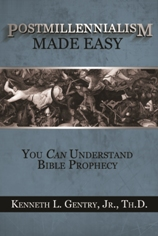
October 28, 2022
THE BIBLE AND CHRISTIAN ETHICS
PMW 2022-082 by Kenneth L. Gentry, Jr.

The starting point for developing a truly Christian ethical system must be the study of Scripture itself. The evangelical, born-again Christian confidently holds that God’s holy will is the perfect standard of righteousness. And he further trusts that God’s will is infallibly, authoritatively, and unchangeably revealed in the Scriptures of the Old and New Testaments. Consequently, the Bible — and the Bible alone — must be the starting point and supreme standard for defining truly Christian ethical behavior.
In the venerable Westminster Confession of Faith (hereinafter WCF) we find a beautiful declaration of the pre-eminency of Scripture as the standard for faith and life:
“It pleased the Lord, at sundry times and in divers manners, to reveal Himself, and to declare that his will unto his church; and afterwards, for the better preserving and propagating of the truth, and for the more sure establishment and comfort of the Church against the corruption of the flesh, and the malice of Satan and of the world, to commit the same wholly unto writing: which maketh the holy Scripture to be most necessary; those former ways of Gods revealing his will unto his people being now ceased.” (WCF 1:1)

______________________________________
God’s Law Made Easy
By Ken Gentry
This book focuses specifically on the question of the relevance of the Old Testament Law today. Christians need to return to a whole-Bible ethic rather than a piece-meal it-seems-to-me morality. God’s Law Made Easy is a good place to start.
For more Christian educational materials: www.KennethGentry.com
_____________________________________
Two Principles
The Scripture is God’s revealed and permanent will for man (Deut. 12:32; Isa. 8:20; Rom. 3:1-4). Because of this, evangelical Christian thought insists upon two important ethical principles:
(1) The ubiquity of ethics. That is, in that man is a moral creature created in the image of God (Gen. 1:26-27; 9:6), everything a man does has moral implications (Psa. 139:1-12; Prov. 15:3; 1 Cor. 10:31; 2 Cor. 5:10).
(2) The sufficiency of Scripture. That is, although God did not reveal detailed responses to each and every possible act of man, nevertheless, Scriptures provide express precepts and/or general principles that adequately govern every contingency (Deut. 8:3b; Psa. 119:105; 2 Tim. 3:16-17).
Again we would do well to note the emphatic and pointed declaration of the Westminster Confession of Faith in this regard: “The whole counsel of God concerning all things necessary for his own glory, man’s salvation, faith and life, is either expressly set down in Scripture, or by good and necessary consequence may be deduced from Scripture: unto which nothing at any time is to he added, whether by new revelations of the Spirit, or traditions of men” (WCF 1:6). Thus, we may confidently and boldly assert that “the supreme judge by which all controversies of religion are to be determined, and all decrees of councils, opinions of ancient writers, doctrines of men, and private spirits, are to be determined, and in whose sentence we are to rest, can be no other but the Holy Spirit speaking in the Scripture” (WCF 1:10).
These doctrinal affirmations themselves flow from the express teaching of Scripture itself: “All Scripture is inspired by God and profitable for teaching, for reproof, for correction, for training in righteousness, that the man of God may be adequate, equipped for every good work” (2 Tim. 3:16-17). To the apostles — who were divinely commissioned and supernaturally gifted bearers of the revelation of God — the Lord Jesus Christ promises: “But when He, the Spirit of truth, comes, He will guide you into all the truth” (John 16:13). God’s Word is unequivocal truth (Psa. 119:160; John 17:17; Rom. 3:4), just as Jesus Christ is the personification of God’s Word (John 1:1; 1 John 1:1; Rev. 19:13) and truth (John 1:17; 14:6). Therefore, God obliges to bring “every thought captive to the obedience of Christ” (2 Cor. 10:5). That is, we must submit every area of life to Christ and his will as revealed in Scripture (Rom. 12:2).
Our Current Need
In the intellectual and spiritual climate of our times, numerous examples of deviating from the norm of Scripture exist. For example, perhaps the foundational heresy of Mormonism is its belief in an open canon which allows for continued “revelation” from God (The Book of Mormon, The Doctrine and Covenants, The Pearl of Great Price, and so on). For example, 2 Nephi 29:3-10 in The Book of Mormon reads:
“Many of the Gentiles shall say: A Bible! A Bible! We have got a Bible, and there cannot be any more Bible. But thus saith the Lord God: . . . Thou fool, that shall say: A Bible, we have got a Bible, and we need no more Bible . . . .Wherefore murmur ye, because that ye shall receive more of my word? . . . Because that ye have a Bible ye need not suppose that it contains all my words; neither need ye suppose that I have not caused more to be written.”
Similarly, the ever-present danger in Pentecostalism and the charismatic movement lies in their frequent claims to continuing direct access to the mind of God. This allegedly comes through supernatural and miraculous revelatory gifts of the Holy Spirit, such as prophetic utterances, divine visions, and heavenly tongues. For instance, J. Rodman Williams writes:
“In prophecy God speaks. It is as simple, and profound, and starling as that! What happens in the fellowship is that the word may suddenly be spoken by anyone present, and so variously, a ‘Thus says the Lord’ breaks forth in the fellowship. . . . Many of us also had convinced ourselves that prophecy ended with the New Testament (despite all the New Testament evidence to the contrary), until suddenly through the dynamic thrust of the Holy Spirit prophecy comes alive again. Now we wonder how we could have misread the New Testament for so long!”
Finally, the clear error of neo-orthodoxy is its denial of propositional truth. This theological paradigm prefers existential subjectivism over objective revelation. That is, dynamic revelation, confrontational crises, and so forth prevail over propositional truth. By way of example, Karl Barth holds that “the Bible is God’s Word so far as God lets it be his Word.”
The Holy Spirit’s Guidance
These widely divergent camps suffer from a common malady: subjectivism in determining the will of God. Unfortunately, even conservative fundamentalism often borders on this error in its ethical reliance upon “the leading of the Holy Spirit” divorced from the Word of God, sign-seeking, special guidance by direct feelings and impressions of the Holy Spirit, and the like. We are greatly tempted to resort to “sanctified feelings” or “holy common sense” for resolving complex ethical issues, especially in our day of instant-this and freeze-dried-that.

Perspectives on Pentecost
By Richard B. Gaffin, Jr.
A careful examination of the New Testament teaching on the gifts of the Spirit. Makes a case for the cessation of tongues at the close of the apostolic era. Gaffin is professor emeritus of biblical and systematic theology at Westminster Theological Seminary, Philadelphia.
For more educational materials: www.KennethGentry.com
The following helpful paragraphs appear in Murray’s article “The Guidance of the Holy Spirit.”
“The basic premise upon which we must proceed is that the Word of God in the Scriptures of the Old and New Testaments is the only infallible rule of practice, as it is also the only infallible rule of faith. Complementary to this basic premise is another, namely, that the Word of God is a perfect and sufficient rule of practice. The corollary of this is that we may not look for, depend upon, or demand new revelations of the Spirit. . . .
“[However], we may still fall into the error of thinking that while the Holy Spirit does not provide us with special revelations in the form of words or visions or dreams, yet he may and does provide us with some direct feeling or impression or conviction which we may regard as the Holy Spirit’s intimation to us of what his mind and will is in a particular situation. The present writer maintains that this view of the Holy Spirit’s guidance amounts, in effect, to the same thing as to believe that the Holy Spirit gives special revelation. And the reason for this conclusion is that we are, in such an event, conceiving of the Holy Spirit as giving us some special and direct communication, be it in the form of feeling, impression, or conviction, a communication or intimation or direction that is not mediated to us through those means which God has ordained for our direction and guidance. In the final analysis this construction or conception of the Holy Spirit’s guidance is in the same category as that which holds to direct and special revelation, and that for the reason that it makes little difference whether the intimation is in the form of impression or feeling or conviction or in the form of a verbal communication, if we believe that the experience which we have is a direct and special intimation to us of what the will of God is. . . . We are abstracting the operation of the Spirit, in respect of guidance, from the various factors which may properly he regarded as the means through which we are to be guided.”s
What the world so needs today — second only to regeneration itself — is a coherent, biblically derived ethical system by which to judge all thought and behavior. Autonomous ethics are internally contradictory (because they are not true) and inherently evil (because they deny God). A truly Christian ethic arises from the self-authenticating Word of the Living God (John 17:17) — not the traditions of men, whether “secular” or “religious” (cf. Matt. 15:3, 6; Mark 7:13). The abiding strength of a truly vital Christianity derives from its sole reliance upon all-sufficient Scripture for all matters concerning faith and practice. The inspired, infallible, inerrant Word of God is and must always be the regulating principle of Christian thought and conduct. Theologian R. B. Kuiper well states this precept: “All Christian teachings, whether doctrinal or ethical, are drawn from the Bible. According to Christianity the acid test of truth and goodness is Scripturalness.”
October 25, 2022
FOUR BASIC MILLENNIAL CAMPS
PMW 2020-081 by Kenneth L. Gentry, Jr.
INTRODUCTION
Theological Terms
The technical theological term that describes the study of Bible prophecy is: “eschatology.” It is based on two Greek words: eschatos, which means “end, last”; logos, which means “word or study.” Thus, “eschatology” is technically “the study of the last things.”
Another technical theological term that has become so popular in modern discussions is: “millennium.” It is based on the Latin: mille, “thousand”; and annum, “year.” Thus, the term means “thousand years.” It is derived from Rev. 20:1–6, the only place in Scripture which associates 1000 years with Christ’s rule.
Basic Positions
In attaching prefixes to the term “millennium” we link the second coming of Christ to the millennium that is mentioned in Rev. 20: amillennial, premillennial, and postmillennial. These three most basic positions may be briefly defined in terms of their chronology as follows:
Amillennialism: The privative a in “amillennialism” emphasizes that there will be no earthly millennial kingdom as such. As amillennialist George Murray puts it: “amillennial, a term which indicates a denial of any future millennium of one thousand years’ duration.”
Premillennialism: The prefix pre indicates that eschatological system that expects a literal earthly millennial kingdom which Christ introduces by his second coming before (pre) it. This kingdom will transpire on earth under Christ’s direct rule.
Postmillennialism: The prefix post points out a lengthy (though not literal 1000 year) earthly period in which Christ’s kingdom influences the world, which period will conclude (hence, “post”) at Christ’s second advent. Postmillennialism tends to see the thousand years as a symbolic figure covering the entirety of the Christian era.
An important subclass of premillennialism arose in the 1830s: “dispensationalism.” Because of its current prominence (Late Great Planet Earth and Left Behind) and its vigorous rejection even by historic premillennialists, we will present it as a fourth, separate and distinct view (see below).
House Divided: The Break-up of Dispensational Theology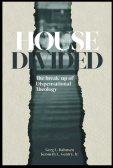
By Greg L. Bahnsen and Kenneth L. Gentry, Jr.
This book demonstrates that dispensational theology has been shattered by its own defenders. They are no longer willing to defend the original system, and their drastic modifications have left it a broken shell.
See more study materials at: www.KennethGentry.com
Interpretive Sorting Device
A helpful interpretive sorting device works quite well in classifying the three basic millennial positions. Two questions tend to sort the positions into one of the three most basic schools. These questions are:
(1) What is the chronology of the kingdom?
(2) What is the nature of the kingdom?
The question of chronology focuses on the timing of Christ’s second advent in relation to the kingdom’s establishment. If his coming is before the kingdom, then the position is premillennial; if it is after the kingdom, then it may be either amillennial or postmillennial.
The question of nature highlights its historical character. If the kingdom will have a radical, objective, transforming influence in human culture, it is either premillennial or postmillennial; if it will not, it is amillennial.
Amillennialism
With the golden-age connotation of the word “millennium,” the label “a–millennial” appropriately describes the system. As Anthony Hoekema notes: “The word amillennial means that the Second Coming of Christ is to be without a millennium.” Kim Riddlebarger states that “amillennialism is an eschatological orientation that awaits no future earthly millennium.”
Descriptive Features
1. The Church Age is the kingdom which the Old Testament prophets predict. God expands his people from the one nation of Israel in the Old Testament to the universal Christian church of the New Testament, making this phase of God’s people the “Israel of God” (Gal 6:16).
2. Christ binds Satan during his earthly ministry at his first coming. His binding prevents Satan from stopping gospel proclamation. This allows for multitudes of sinners to convert to Christ and insures some restraint upon evil.
3. Christ rules spiritually in the hearts of believers. We may expect occasional, short-lived influences of Christianity on culture and society, especially when Christians live out the implications of their faith.
4. History will gradually worsen as evil’s growth accelerates toward the end. This will culminate in the great tribulation, with the arising of a personal Antichrist.
5. Christ will return to end history, resurrect all men, and conduct the Final Judgment, and establish the eternal order. The eternal destiny of the redeemed may be either in heaven or in a totally renovated new earth.

He Shall Have Dominion
(paperback by Kenneth Gentry)
A classic, thorough explanation and defense of postmillennialism (600+ pages). Complete with several chapters answering specific objections.
See more study materials at: www.KennethGentry.com
Dispensationalism
This term highlights the view that history is divided into seven distinct compartments or “dispensations.” The final dispensation is the millennium.
Paul Benware provides a thorough definition of dispensationalism from which I will draw several key elements:
Certain fundamental elements characterize this type of premillennialism. . . . The belief that the Lord Jesus Christ returns to this earth before the establishment of His kingdom. . . . The belief in two resurrections, which are separated by a thousand years. . . . That the millennial kingdom is a literal kingdom that will exist on this present earth. . . . That the millennial kingdom will be established only after human kingdoms have come to an end. . . . That the purpose of the millennial kingdom is to fulfill the covenant promises made to Abraham and his descendants. Premillennialism thus gives a much greater place to the nation of Israel than the other major millennial views.
Descriptive Features
1. Redemptive history is divided up into seven categorically distinct dispensations, wherein God works with men under each dispensation in different ways. Hence, the name “dispensationalism.”
2. Christ offers renewed Davidic Kingdom — an earthly, political structure — to the Jews in the first century. They reject it, leading him to postpone it until the future.
3. The Church Age is a wholly unforseen and distinct era in the plan of God. It was altogether unknown to and unexpected by the Old Testament prophets.
4. God has a separate and distinct program and plan for racial Israel, as distinguished from the church. The church of Jesus Christ is a parenthetical aside in the original plan of God.
5. The church may experience occasional small scale successes in history, but ultimately she will lose influence, fail in her mission, and become corrupt as worldwide evil intensifies toward the end of the Church Age.
6. Christ will return secretly in the sky to rapture living saints and resurrect the bodies of deceased saints (the first resurrection). He is removing them out of the world before the great tribulation. The judgment of the saints transpires in heaven during the seven-year great tribulation period before Christ’s bodily return to the earth.
7. At the conclusion of the seven-year great tribulation, Christ will return to the earth in order to establish and personally administer a Jewish political kingdom headquartered at Jerusalem for 1,000 years. During this time, Satan will be bound, and the temple and sacrificial system will be reestablished in Jerusalem as memorials.
8. Toward the end of the Millennial Kingdom, Satan will be loosed so that he may surround and attack Christ at Jerusalem.
9. Christ will call down fire from heaven to destroy his enemies. The second resurrection and judgment of the wicked will occur, initiating the eternal order.
Historic Premillennialism
According to historic premillennialist Wayne Grudem, this view holds that:
The present church age will continue until, as it nears the end, a time of great tribulation and suffering comes on the earth . . . . After that time of tribulation at the end of the church age, Christ will return to earth to establish a millennial kingdom. When he comes back, believers who have died will be raised from the dead, their bodies will be reunited with their spirits, and these believers will reign with Christ on earth for one thousand years. During this time, Christ will be physically present on the earth in his resurrected body, and will reign as King over the entire earth. The believers who have been raised from the dead, and those who were on earth when Christ returns, will receive glorified resurrection bodies that will never die, and in these resurrection bodies they will live on the earth and reign with Christ. Of the unbelievers who remain on earth, many (but not all) will turn to Christ and be saved. Jesus will reign in perfect righteousness and there will be peace throughout the earth. At the beginning of this time Satan will be bound and cast into the bottomless pit so that he will have no influence eon the earth during the millennium (Rev. 20:1–3).
At the end of the thousand years Satan will be loosed form the bottomless pit and will join forces with many unbelievers who have submitted outwardly to Christ’s reign but have inwardly been seething in rebellion against him. Satan will gather these rebellious people for battle against Christ, but they will be decisively defeated. Christ will then raise from the dead all the unbelievers who have died throughout history, and they will stand before him for final judgment. After the final judgment has occurred, believers will enter into the eternal state.
Descriptive Features
1. The New Testament era church is the initial phase of Christ’s kingdom, which the Old Testament anticipates especially in its prophetic books.
2. The New Testament church may win occasional victories in history, but ultimately she will fail in her mission, lose influence, and become corrupted as worldwide evil increases toward the end of the current era, the Church Age.
3. The church will pass through a future, worldwide, unprecedented time of travail. During this period a personal Antichrist will arise, possessing great religious and political power. This era is known as the great tribulation, which will punctuate the end of contemporary history. Historic premillennialists differ significantly from dispensationalists in that their system is posttribulational.
4. Christ will return at the end of the tribulation to rapture the church, resurrect deceased saints, and conduct the judgment of the righteous in the “twinkling of an eye.”
5. Christ then will descend to the earth with his glorified saints, fight the battle of Armageddon, bind Satan, and establish a worldwide, political kingdom, which Christ will personally administer for 1,000 years from Jerusalem. (Historic premillennialists often do not demand the Revelation’s 1000 years be a literal time frame.)
6. At the end of the millennial reign, Satan will be loosed and will cause a massive rebellion against the millennial kingdom and a fierce assault against Christ and his saints.
7. God will intervene with fiery judgment to rescue Christ and the saints. The resurrection and the judgment of the wicked will occur and the eternal order will begin. The eternal order may be either a recreated material new heavens and new earth, or it may be simply a heavenly environment.
Postmillennialism
We may succinctly define postmillennialism as follows:
Postmillennialism holds that the Lord Jesus Christ establishes his kingdom on earth through his preaching and redemptive work in the first century and that he equips his Church with the gospel, empowers her by the Spirit, and charges her with the Great Commission to disciple all nations. Postmillennialism expects that eventually the vast majority of men living will be saved. Increasing gospel success will gradually produce a time in history prior to Christ’s return in which faith, righteousness, peace, and prosperity will prevail in the affairs of men and of nations. After an extensive era of such conditions the Lord will return visibly, bodily, and gloriously, to end history with the general resurrection and the final judgment after which the eternal order follows.
Descriptive Features
1. Postmillennialism holds that the Lord Jesus Christ founds his Messianic kingdom on the earth during his earthly ministry and through his redemptive labors. His establishing the “kingdom of heaven” fulfills Old Testament prophetic expectations regarding the coming kingdom. The kingdom which Christ preaches and presents is not something other than that expected by the Old Testament saints. In postmillennialism the church is the fulfilled/transformed Israel and is even called “the Israel of God” (Gal 6:16).
2. The kingdom’s fundamental nature is essentially redemptive and spiritual, rather than political and corporeal. Although it has implications for the political realm, postmillennialism is not political, offering a kingdom in competition with geopolitical nations for governmental rule. Christ rules his kingdom spiritually in and through his people in the world, as well as by his universal providence.
3. Because of the intrinsic power and design of Christ’s redemption, his kingdom will exercise a transformational socio-cultural influence in history. This will occur as more and more people convert to Christ, not by a minority revolt and seizure of political power in history nor by the catastrophic imposition of Christ at his second advent from outside of history. As Rushdoony notes: “The key to remedying the [world] situation is not revolution, nor any kind of resistance that works to subvert law and order. . . . The key is regeneration, propagation of the gospel, and the conversion of men and nations to God’s law-word.” This is because “evil men cannot produce a good society. The key to social renewal is individual regeneration.”
4. Postmillennialism, therefore, expects the gradual, developmental expansion of Christ’s kingdom in time and on earth before the Lord returns to end history. This will proceed by a full-orbed ministry of the Word, fervent and believing prayer, and the consecrated labors of Christ’s Spirit-filled people. The ever-present Christ is directing kingdom growth from his throne in heaven, where he sits at God’s right hand.
5. Postmillennialism confidently anticipates a time in earth history (continuous with the present) in which the very gospel already operating will win the victory throughout the earth, fulfilling the Great Commission. “The thing that distinguishes the biblical postmillennialist, then, from amillennialists and premillennialists is his belief that the Scripture teaches the success of the great commission in this age of the church” (Greg Bahnsen). The overwhelming majority of men and nations will be Christianized, righteousness will abound, wars will cease, and prosperity and safety will flourish. “It will be marked by the universal reception of the true religion, and unlimited subjection to the sceptre of Christ” (David Brown). “It shall be a time of universal peace.” “It will be characterised by great temporal prosperity” (Lorraine Boettner).
6. Postmillennialists look forward to a great ‘golden age’ of spiritual prosperity continuing for centuries, or even for millenniums, during which time Christianity shall be triumphant over all the earth. After this extended period of gospel prosperity, earth history will draw to a close by the personal, visible, bodily return of Jesus Christ (accompanied by a literal resurrection and a general judgment) to introduce his blood-bought people into the consummative and eternal form of the kingdom. And so shall we ever be with the Lord.
 Your Hope in God’s World (Kenneth Gentry)
Your Hope in God’s World (Kenneth Gentry)
5 DVDs; 5 lectures
This series of lectures presents the theological and exegetical argument for the postmillennial hope in our fallen world. The last lecture answers the major practical, theological, and exegetical objections to postmillennialism. An excellent series for both introducing and refreshing one’s understanding of postmillennialism.
See more study materials at: www.KennethGentry.com
October 21, 2022
DISINHERITING REBELLIOUS CHILDREN
 PMW 2022-080 by Kenneth L. Gentry, Jr.
PMW 2022-080 by Kenneth L. Gentry, Jr.
Postmillennialism is church-centered, family-oriented, culture-impacting, and future-directed. Training up children in the way they should go is a first-order obligation of the covenantal postmillennialist. But what is the Christian postmillennialist to do when his children go radically astray?
I believe the Bible and its covenantal theology direct believers to disinherit irretrievable, wayward children. And here are the reasons why.
First, the priority of God.
those who are God’s people are to tithe to the Lord their first fruits. This is to show that all that they have comes from God (Dt. 8:18; Jms 1:18) and ultimately belongs to him:
Deut. 8:18 “But you shall remember the Lord your God, for it is He who is giving you power to make wealth, that He may confirm His covenant which He swore to your fathers, as it is this day.
James 1:17 “Every good thing bestowed and every perfect gift is from above, coming down from the Father of lights, with whom there is no variation, or shifting shadow.”
We are stewards of God’s gracious resources which he has entrusted to our care.

Covenantal Theonomy
(by Ken Gentry)
A defense of theonomic ethics against a leading Reformed critic. Engages many of the leading objections to theonomy.
See more study materials at: www.KennethGentry.com
Second, the source of wealth.
The wealth God gives us is for the purpose of confirming (promoting, securing, honoring) his covenant: Deut. 8:18: But you shall remember the Lord your God, for it is He who is giving you power to make wealth, that He may confirm His covenant which He swore to your fathers, as it is this day.
If our wealth were given to unbelievers we would be funding the kingdom of Satan rather than the kingdom of God. Even though God gave us our wealth. After all, we are to “seek first the kingdom of God and his righteousness, then all these things will be added unto us.”
Third, the Law of God.
God’s Law bligates the parent of a “stubborn and rebellious son” to turn him over to authorities for capital punishment (Dt 21:18-21). If the parents have a moral and legal obligation that goes so against the maternal/paternal grain, an obligation to act against their unholy son to the point of seeking his death, it appears to me that an obligation short of that dramatic action should preclude the parent from leaving God’s gifts to the unbelieving child (though he is not a criminal).
Fourth, the pattern of Scripture.
God leaves us a pattern of denying an inheritance to the unbeliever, when he denies it to even one of his own children who behaves in an unbelieving fashion:
Numbers 18:20 : Then the Lord said to Aaron, “You shall have no inheritance in their land, nor own any portion among them; I am your portion and your inheritance among the sons of Israel.
God’s Law Made Easy (by Ken Gentry)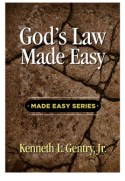
Summary for the case for the continuing relevance of God’s Law. A helpful summary of the argument from Greg L. Bahnsen’s Theonomy in Christian Ethics.
See more study materials at: www.KennethGentry.com
Fifth, the example of the Canaanites.
God takes the land of the unbelieving (and criminal Canaanites) and gives it to Israel for an inheritance. That is, God disinherits the unbelieving and turns their inheritance over to his faithful people.
Deut. 4:38: driving out from before you nations greater and mightier than you, to bring you in and to give you their land for an inheritance, as it is today.
Indeed, God intends the wealth of the sinner to be stored up for the righteous, not vice versa (Prov. 13:22b).
Sixth, the lot of the trouble-maker.
The inheritance of the troubler of one’s house receives no inheritance:
Proverbs 11:29: “He who troubles his own house will inherit wind, And the foolish will be servant to the wisehearted.”
Proverbs 17:2: “A servant who acts wisely will rule over a son who acts shamefully, And will share in the inheritance among brothers.”
Matthew 23:38: “Behold, your house is being left to you desolate!”
Matthew 7:6: “Do not give what is holy to dogs, and do not throw your pearls before swine, lest they trample them under their feet, and turn and tear you to pieces.”
Matthew 8:11-12: “And I say to you, that many shall come from east and west, and recline at the table with Abraham, and Isaac, and Jacob, in the kingdom of heaven; but the sons of the kingdom shall be cast out into the outer darkness; in that place there shall be weeping and gnashing of teeth.”
Matthew 10:37: “He who loves father or mother more than Me is not worthy of Me; and he who loves son or daughter more than Me is not worthy of Me.”
Thus, as sad as it may be humanly-speaking, we must “seek first the king of God and his righteousness” (Matt. 6:33).
October 18, 2022
THE KEY TO OPENING REVELATION
 PMW 2022-079 by Kenneth L. Gentry, Jr.
PMW 2022-079 by Kenneth L. Gentry, Jr.
There are several keys to interpreting the Book of Revelation. But the key key is that of John’s statement regarding the prophetic events being near. When I discuss Revelation with folks I begin by urging them to read the first three verses. Once the shock wears off their faces, the gears in their head will often begin to turn.
Thus, the leading preterist evidence derives from John’s temporal delimitations, which he emphasizes by strategic placement, didactic assertion, frequent repetition, and careful variation.
He strategically places them twice in his introduction (1:1, 3) and five times in his conclusion (22:6, 7, 10, 12, 20), thereby bracketing the highly wrought drama within (4:1–22:6). In these didactic passages John employs two terms demanding preterism: tachos / tachu (1:1, cp. 22:7, 12, 20) and eggus (1:3; cp. 22:10). For example:
The Revelation of Jesus Christ, which God gave Him to show to His bond-servants, the things which must shortly [tachos] take place. . . . Blessed is he who reads and those who hear the words of the prophecy, and heed the things which are written in it; for the time is near [eggus]. (1:1a, 3)
John immediately impresses upon his reader the nearness of his prophetic events.
Lexicographers agree on the temporal significance of tachos in Revelation: The Baur-Arndt-Gingrich-Danker Lexicon (BAGD) notes that en tachei means: “soon, in a short time Lk 18:8; Ro 16:20; 1 Ti 3:14 v.1; Rv 1:1; 22:6; 1 Cl 65:1; shortly Ac 25:4.” Thayer offers the following range of meanings: “quickness, speed and quickly, shortly, speedily, soon,” listing Revelation 1:1 and 22:6 with the “speedily, soon” entries. Abbott-Smith concurs: 1:1 and 22:6 mean “quickly, speedily, soon.”
[image error]For more information and to order click here.
" data-image-caption="" data-medium-file="https://postmillennialismtoday.files...." data-large-file="https://postmillennialismtoday.files...." class="alignright size-full wp-image-209" src="https://postmillennialismtoday.files...." alt="Navigating the Book of Revelation: Special Studies on Important Issues" />Navigating the Book of Revelation (by Ken Gentry)
Technical studies on key issues in Revelation, including the seven-sealed scroll, the cast out temple, Jewish persecution of Christianity, the Babylonian Harlot, and more.
See more study materials at: www.KennethGentry.com
Greek text editors F. J. A. Hort, Kurt Aland, and Howard Marshall agree. Hort translates it “shortly, soon.” Aland comments: “In the original text, the Greek work used is tachu, and this does not mean ‘soon,’ in the sense of ‘sometime,’ but rather ‘now,’ immediately.” Marshall cites Revelation 1:1 and 22:6 as evidence that the normal use of the phrase en tachei “suggest[s] that soon is the meaning.”
In fact, all English versions translate it either as: “soon” (NIV, RSV, Beck, NRSV, NAB, CEV), “shortly” (KJV, ASV, Weymouth, NEB, NASB, NKJV), or “very soon” (Moffatt, Phillips, Williams, TEV). Tachos obviously indicates temporal brevity elsewhere (e.g., Lk 18:8; Ac 12:7; Ro 16:20). The same is true of its related form tachus (Mt 5:25; Mk 9:39; Lk 15:22; cp. Rev 2:16; 3:11; 11:14; 22:7, 12, 20).
This evidence is reinforced by John’s linking tachos with eggus in the same contexts, as if to provide a two-fold witness (1:1, 3; 22:6, 10). BAGD provides the following entry for eggus: “of time near a. of the future: kairos Mt 26:18; Rv 1:3; 22:10.” The other lexicons cited above concur. Theological Dictionary of the New Testament notes that the term means “temporally near at hand” and observes that “like the Synpt., Rev. uses eggus only as a term for the near coming of the kingdom of God. Thus we have ho gar kairos eggus in 1:3; cf. 22:10” (3:330, 331).
The various samples of eggus in the NT all agree: some relating spatial, others temporal nearness (Mt 24:32, 33; 26:18; 13:28, 29; Lk 19:11; 21:30, 31). And again, all translations of Revelation agree; all versions cited above have either “near” or “at hand.”

Blessed Is He Who Reads: A Primer on the Book of Revelation
By Larry E. Ball
A basic survey of Revelation from the preterist perspective.
It sees John as focusing on the destruction of Jerusalem and the temple in AD 70.
For more Christian studies see: www.KennethGentry.com
Perhaps the most interesting proof of the meaning of these terms is the various competing, innovative, counter-intuitive attempts to get around their obvious significance! Indeed, if these terms do not express temporal nearness, what terms could John have used to do so? I am firmly convinced John prophesies the fast approaching destruction of the Temple in A.D. 70.
October 14, 2022
THE PLAGUES AND EGYPT’S GODS
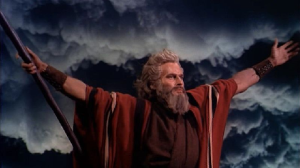 PMW 2022-078 by Kenneth L. Gentry, Jr.
PMW 2022-078 by Kenneth L. Gentry, Jr.
The ten plagues that befall Egypt during the period of the exodus, were not only designed to get Israel released from bondage. They were also designed to directly confront the puny gods of Egypt. We need to recognize that the same God who sent the plagues against the gods of the mightest nation in that era is the same God we serve today. And he will overthrow the modern gods of the nations. In this article I will highlight the ten plagues as challenges to Egypt’s gods
The ten plagues against Egypt are:
1. The turning of water into blood (Exo. 7:15–25).
2. The swarming of frogs (Exo. 8:3–15).
3. The turning of dust into gnats (Exo. 8:16-19)
4. The swarming of flies (Exo. 8:21–29).
5. The deadly pestilence on livestock (Exo. 9:1-7).
6. The painful boils on beast and man (Exo. 9:8–12).
7. The destructive and deadly storm of hail and fire (Exo. 9:18–35).
8. The catastrophic swarm of locusts (Exo. 10:1-20).
9. The thick darkness for three days (Exo. 10:21-29).
10. The death of the firstborn animals and men (Exo. 11:1–10; 12:29–32).
The Bible shows that the plagues are ultimately directed against the gods of Egypt: “against all the gods of Egypt I will execute judgments” (Exo. 12:12b; cp. Exo. 15:11; 18:11; Num. 33:4; Jer. 46:25). In this study I will present a collection of evidences for the focus of the plagues.
First plague. By turning the water to blood, God is defeating the god/goddess Hapi who was personified in the Nile River. Some ancient Egyptian texts even call the Nile by the name Hapi, a hermaphroditic god of fertility. Khnum was the god of the source of the Nile. Rather than the Nile bringing life to Egypt, under God’s judgment it pictures (Exo. 7:17, 21) and effects (Exo. 7:18, 20) death.

Revelation, God and Man
(24 mp3 lectures by Ken Gentry)
Formal college course on the doctrines of revelation, God, and man.Opens with introduction to the study of systematic theology. Excellent material for personal study or group Bible study. Strongly Reformed and covenantal in orientation.
See more study materials at: www.KennethGentry.com
Second plague. By causing the swarming frogs, God is defeating the goddess Hekhet, who was pictured as a female human with a frog’s head. She was supposed to constrain the frogs, but God overwhelms her power and multiplies them.
Third and fourth plagues. These plagues involve swarming insects (gnats and flies). These two plagues seem to be directed at least partly against the god Kheprer who was symbolized by a flying beetle. The god was pictured as a human male with a scarab’s head. His name meant “come into being” and he was the god of creation and rebirth. God overwhelmed this god of creation by creating extreme swarms of pests.
Fifth plague. The pestilence on the livestock is directed at the various bull cults of Egypt, such as Buchis, Apis, and Mneuis. Other gods and goddesses were associated with livestock, such as cows and pigs. The bull particularly represented strength and vitality. These gods were not strong enough to resist the Lord God Almighty (Exo. 6:3).
Sixth plague. The boils appear to serve as a denunciation of Sekhmet, the goddess of healing who could avert plagues. She was the special protector of the Pharaohs. Her healing work proves fruitless against God’s plagues.

Sovereignty of God
(7 mp3 Gentry downloadable sermons)
In these seven sermons will be found a practical demonstration of God’s absolute sovereignty.
This series serves as an excellent introduction to this difficult doctrine.
See more study materials at: KennethGentry.com
Seventh plague. Several goddesses are associated with the sky from which the hail and fire fall. Nut was the sky goddess, Shu was the goddess of air, and Tefnut was the goddess of rain. The divine hail and fire falling from the sky demonstrate her powerlessness before God.
Eighth plague. Locusts caused enormous destruction to crops and thus the food supply in Egypt. Therefore the Egyptians worshiped Senehem who protected from locust and other pest swarms. This god also fails before the Lord’s onslaught.
Ninth plague. The god who personified the sun was Amon-Re, the leading god of the Egyptian pantheon. He daily brought sunlight to the world. But he is rendered impotent for three days in the plague of darkness. God is the giver and withholder of light, not Amon-Re.
Tenth plague. Egypt was ruled by a succession of Pharaohs. The tenth plague destroys all the firstborn of the Egyptians, including Pharaoh’s firstborn son (Exo. 11:5; 12:29), disrupting dynastic succession. This plague also strikes out at Anubis, the god of the mummification and the afterlife, as well as the protector of graves. The plague overthrows the power of these god and shows God is the giver and taker of life.
Moses challenged mighty Egypt and their pantheon of gods. And he won a glorious victory for God and his people. Our hope in challenging this dark world lies in God. We must seek God’s power to effect revival and reformation in our world today.
“For great is the LORD, and greatly to be praised; He also is to be feared above all gods. For all the gods of the peoples are idols, But the LORD made the heavens. Splendor and majesty are before Him, Strength and joy are in His place. (1 Chron. 16:25–27)
October 11, 2022
THE NATIONS AND THE GREAT COMMISSION
 PMW 2022-077 by Kenneth L. Gentry, Jr.
PMW 2022-077 by Kenneth L. Gentry, Jr.
Introduction
An interested reader sent me a question regarding the Great Commission. The question was two pages long, but I will edit it down to a manageable size. He wrote:
I have a question about a certain verse that I believe you use in a certain way…. The Verse is Matthew 28:19…. My question is this: In what sense do you understand Jesus telling His disciples to “make disciples of all nations?” Can you break that down for me and clarify? I know in the KJV it says to “teach” and that has been discovered by many to be wrong and it seems the better translation is “to make disciples of all nations” I always thought that you believed it meant each particular nation would be through the “preaching of the gospel” would be Christianized. Each nation in a universal but limited sense. Not all but the majority of the people of each nation would be made disciples of Christ through the “things that Jesus taught the disciples”….
[The reader cites a scholarly article he has read on the matter. He notes:] The Aorist Imperative form of this verb lends itself to the expression of a simple activity, like the calling to the commitment to follow Jesus, which each one of the disciples who was listening to this commission had previously done. “Baptizing them” would also be understood by these same disciples as being similar to the individual commitment each of them had to make before they were baptized by John the Baptist (cp. Mark 1:5)….
There is another issue in Matt 28:19-20, and that is how to take the participles – “baptizing and teaching” in relation to the main verb “make disciples”. The commentary you quoted interpreted them as participles of means… “Make disciples of all nations BY baptism and BY instruction.” But the word “by” is added for interpretation and is not in the text.
I hope I have saved the relevant portions of his extended question. And I believe I have. So now, to work!
Thanks for reading and thinking through the issues. I recommend your reading my book The Greatness of the Great Commission for a fuller answer.
Ethnos meaning
Regarding the cultural implications of the Great Commission, I would note:
First, it is significant that Jesus chose the word ethnos in his command, rather than basileia (which suggests political kingdoms, national entities) or anthropos (which suggest individual men). My understanding of “nations” (Gk. ethnos) is that it means “men in their Calvin and Culture: Exploring a Worldview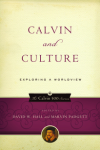 Ed. by David Hall No other Christian teachings in the past five hundred years have affected our Western culture as deeply as the worldview of John Calvin. It extends far beyond the theological disciplines. See more study materials at: www.KennethGentry.com
Ed. by David Hall No other Christian teachings in the past five hundred years have affected our Western culture as deeply as the worldview of John Calvin. It extends far beyond the theological disciplines. See more study materials at: www.KennethGentry.com

Greatness of the Great Commission (by Ken Gentry)
An insightful analysis of the full implications of the great commission. Impacts postmillennialism as well as the whole Christian worldview.
See more study materials at: www.KennethGentry.com
Second, this understanding is allowed by Jesus’ use of the word ethnos and it is actually encouraged by his addition of the means of the discipling: by “teaching them to observe all that I 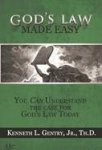 God's Law Made Easy (by Ken Gentry)
God's Law Made Easy (by Ken Gentry)
Greatness of the Great Commission (by Ken Gentry)
An insightful analysis of the full implications of the great commission. Impacts postmillennialism as well as the whole Christian worldview.
See more study materials at: www.KennethGentry.com
">worldview orientation (cp. 2 Cor. 10:4–5).Third, this understanding of ethnos well supplements Jesus’ statement in John 3:17: “God did not send the Son into the world to judge the world, but that the world might be saved through Him.” The kosmos as “a system of men and things” is the goal of the saving work of God in Christ. God did not intend to pluck brands from the fire, but to apply his universal authority (Matt. 28:18) over the whole world. We should note with John Nolland (The Gospel of Matthew: New International Greek Testament Commentary [2005], p. 1270) that “Matthew shares the general Jewish impulse to view true religion as involving a way of life and not simply a pattern of beliefs. So what is to be taught is to keep … what has been commanded.” This is culture-creating.
Thus, I believe all cultures as cultures are to be “discipled,” i.e., brought under Christian instruction and influence. The cultures and the world will be discipled one person at a time, to be sure, but they will be discipled as cultures in all their defining implications.
In the Apostolic church we see the problem of the tendency of Jewish culture (with its ceremonial demands and distinctive social markers) attempting to restrict and govern the gospel (Acts 15; Galatians). This must be overcome — through discipling. The gospel must produce not simply individual converts, but converts governed in all their life relations by the universal authority of Christ.
Participle significance
Regarding the question of the significance of the participles and their functioning as “means,” I believe that these participles are in fact examples of the “participle of means.” As Daniel Wallace notes in his Greek Grammar: Beyond the Basics (p. 629) the “participle of means could be called an epexegetical [explanatory] participle in that it defines or explains the action of the controlling verb.” He adds that “the participle of means is almost always contemporaneous with the main verb.” Thus, the making of disciples is to be done by baptizing and teaching them. He lists Matt. 28:19–20 as examples of the participle of means (p. 630).
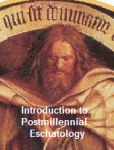
Introduction to Postmillennial Eschatology (10 downloadable mp3 lectures)
by Ken Gentry
Lecture presentations and some classroom interaction. Very helpful definition, presentation, and defense of postmillennialism.
See more study materials at: www.KennethGentry.com
Later on p. 645, Wallace observes regarding the Great Commission participles (baptizing; teaching) that “they obviously make good sense as participles of means; i.e., the means by which the disciples were to make disciples was to baptize and the to teach.” Charles Quarles (Exegetical Guide to the Greek New Testament [2017], p. 352) sees these participles as either participles of means or attendance circumstances (i.e., coordinate with the main verb). R. T. France agrees (The Gospel of Matthew: NICNT [2007], p. 1115), noting that these participles “spell out the process of making disciples.” Davies and Allison (Matthew: International Critical Commentary [1997], p. 686) agree, noting that the “general imperative … is filled out … by what follows: baptism and instruction in obedience.” David L. Turner (Matthew: Baker Exegetical Commentary on the New Testament [2008], p. 689) concurs, noting that the participles explain “how disciples are made.”
As Craig Keener (The Gospel of Matthew: A Socio-Rhetorical Commentary [2009], p. 718) puts it: “one should make disciples for Jesus by going, baptizing, and ‘teaching.’” Craig Blomberg (Matthew: The New American Commentary [1992], p. 431) agrees: “The verb ‘make disciples’ also commands a kind of evangelism that does not stop after someone makes a profession of faith. The truly subordinate participles in v. 19 explain what making disciples involves: ‘baptizing’ them and ‘teaching” them obedience to all of Jesus’ commandments.”
According to Charles Quarles (Exegetical Guide to the Greek New Testament: Matthew [2017]), the aorist imperative of matheteuo “expresses urgency” (p. 351). He also notes that the participles “baptizing” and “teaching” are expressed by the “ptc. of means,” thus implying the understanding of “by.” Though it is not crucial to add “by” to the translation because the statement could be read literally as: “make disciples of all the nations, baptizing them, etc.”
Regarding the statement that the “Aorist imperative form of this verb lends itself to the expression of a simple activity, consider the following (very briefly!). Charles Quarles (Exegetical Guide to the Greek New Testament: Matthew [2017]), notes instead that the presence of the aorist imperative of matheteuo “expresses urgency” (p. 351).
Though he was not postmillennial, A. T. Robertson (Word Pictures in the New Testament, 1:245) speaks of the Great Commission as “the campaign for world conquest.” I believe he has captured the sense of Jesus’ command.
I hope this has been helpful. Keep studying!
 The Beast of Revelation (246pp); Before Jerusalem Fell: Dating the Book of Revelation (409pp); Navigating the Book of Revelation: Special Studies on Important Issues (211pp).
The Beast of Revelation (246pp); Before Jerusalem Fell: Dating the Book of Revelation (409pp); Navigating the Book of Revelation: Special Studies on Important Issues (211pp).
In the Logos edition, these volumes by Ken Gentry are enhanced by amazing functionality. Important terms link to dictionaries, encyclopedias, and a wealth of other resources in your digital library. Perform powerful searches to find exactly what you’re looking for. Take the discussion with you using tablet and mobile apps. With Logos Bible Software, the most efficient and comprehensive research tools are in one place, so you get the most out of your study.
For more study materials, go to: KennethGentry.com
October 7, 2022
STRUCTURAL STRANDS IN NT ESCHATOLOGY
PMW 2022-078 by John Murray
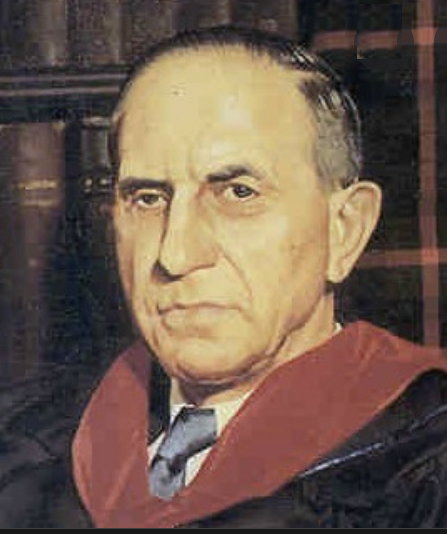
(Gentry Note: The material below was given by Professor John Murray of Westminster Theological Seminary at the Evangelical Theological Society meeting in 1954.)
INTRODUCTION
There are three distinct strands in the structure of New Testament eschatology: (1) the strand represented by “the last days”; (2) the strand expressed in the contrast between “this age” and “the age to come”; and (3) the strand intimated in such expressions as “our citizenship is in heaven” (Phil. 3:20) and “we have been raised up together and made to sit together in the heavenlies in Christ Jesus” (Eph. 2:6; cf. Col. 3:1-3). We might speak of these three strands respectively as anticipated eschatology, prospective eschatology and projective eschatology.
It might appear that there is incoherence or incompatibility here. If eschatology is anticipated or realized, how can it be prospective; and if it is projective and we are now conceived of as projected into the realm of the heavenly, how can there be any place for hope—in other words, for the prospective? “Hope that is seen is not hope: for what a man sees, why does he still hope for?” (Rom. 8:24). That the New Testament is not conscious of any incompatibility is quite apparent from the fact that in the Pauline teaching, for example, where the prospective and the projective are conspicuously in evidence, both are uttered in the same breath. Paul says “our citizenship is in heaven”—that is the projective. But he immediately adds “from which also we look for the Savior, the Lord Jesus Christ”—that is definitely prospective. The one did not displace the other nor did the one make the other superfluous. Again, after having referred to Christ’s location at the right hand of God, he says, “Your life is hid with Christ in God” but adds immediately, “When Christ, our life, will be manifested, then we also shall be made manifest with him in glory” (Col. 3:4). It is superficial understanding, to say the least, that cannot perceive the congruity of these two perspectives. It is an impoverished faith indeed that does not contain them both.
THE FIRST STRAND: “THE LAST DAYS”
The structure represented by “the last days” is to the effect that “the last days” are now running their course and began to run their course with the first advent of Christ, at least not later than his public ministry. There is good reason to believe that New Testament believers recognized in the messianic advent the fulfillment of the glory, blessing and peace associated with the last days in Old Testament prophecy. There is then a distinctively retrospective factor in this concept—it is the fact of Christ’s past advent that gives warrant for this perspective and for the conviction that the last days have begun to run their course. In other words, it is the eschatological significance of the past advent that gives to these days the eschatological character that belongs to them as the last days. This segment of history is “the consummation of the ages” (Heb. 9:26) and “the ends of the ages” (1 Cor. 10:11) because Christ has appeared to put away sin, to accomplish redemption.
But while there is this distinctly retrospective aspect to this concept, there is also a prospective. In the very concept, there is the intimation of terminus—it would hardly be feasible to regard the last days as continuing for ever and identify them with the age to come. It is the idea of segment that is conveyed and therefore a period of time with not only a beginning but also an end; it is the last segment of the days. Hence the eschatological terminus is intimated as well as the eschatological inception.
Have We Missed the Second Coming:
A Critique of the Hyper-preterist Error
by Ken Gentry
This book offers a brief introduction, summary, and critique of Hyper-preterism. Don’t let your church and Christian friends be blindfolded to this new error. To be forewarned is to be forearmed.
For more Christian educational materials: www.KennethGentry.com
“The last days” are charged, therefore, with eschatological realization by reason of the eschatological significance of that event from which they take their inception and they are charged with eschatological expectation because they announce the eschatological terminus. History has begun to wind up its lines, but it has not yet wound them up. The eschatological drama has begun, but it has not been consummated. The fact that it has begun plus the fact that it will be consummated charges the present with eschatological imminence. These days are looking for and hastening the advent of the Lord in glory. They fill the present with hope for believers and warning for unbelievers.
While this prospective significance of the last days must be fully appreciated, yet, by way of distinctiveness, it is the retrospective that is most in evidence. The concept attaches itself very largely to the first coming of Christ and to the eschatological significance of that event. These are the last days because Christ has come in the flesh. This retrospective emphasis is complementary to the realized eschatology which it intimates.
THE SECOND STRAND: THIS AGE AND THE AGE TO COME
The second strand in the structure of New Testament eschatology is the antithetic—the contrast between this age and the age to come. It can hardly be questioned but it is the prospective, the hope of the future, that is most prominent in this perspective—in a word, the expectation of the age to come. It is quite consonant with this perspective that the present age has a distinctly depreciatory complexion—it is an evil age and Satan is the God of this age (Gal. 1:4; 2 Cor. 4:4). Because it is evil, the rulers of this age did not know the Lord of Glory (1 Cor. 2:6-8). This depreciation of the present age arises to a considerable extent from the contrast with the age to come. The age to come is the age of consummation, of consummated righteousness and bliss and therefore bears a distinctly favorable complexion. So much is this the case that it can be equated with the reward of the righteous and therefore represented as unqualifiedly good (Lk. 20:35). The forces of the kingdom of God, the powers operative in the dispensation of the gospel, powers which have broken into this world’‘s history for the salvation of men, are the powers of the age to come (Heb. 6:5). It is the age associated with and introduced by the appearing of the glory of the great God and our Savior Jesus Christ. For this reason it is no wonder that it should not only be coordinated with but practically identified with the eschatological hope.
These two strands of New Testament eschatology are on the horizontal line of vision. Because this is the case they have to be related to each other on the horizontal line of history. It is not difficult to make this correlation. We cannot indeed equate this age with the last days. In the Old Testament perspective, the last days were future; in the New Testament, they are present. From the standpoint of the New Testament writers, they must have recently begun to run their course. And we can say with good reason that they were conceived to have begun to run their course with the first advent of Christ. We cannot say this of the present age. We have no evidence by which to relate its inception to the advent of Christ. And the presumption is that the present age was conceived of as the whole of temporal history up to the second advent of the Lord. All we can say, therefore, is that the present age comprises the last days and the latter is the final segment of the present age. These two are therefore coincident to this extent—that the last days are the last lap of this present age. This explains a common characteristic of both. This age is evil, the last days are characterized by many evils. In them scoffers abound and perilous times come.
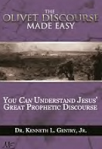
Olivet Discourse Made Easy (by Ken Gentry)
Verse-by-verse analysis of Christ’s teaching on Jerusalem’s destruction in Matt 24. Shows the great tribulation is past, having occurred in AD 70, and is distinct from the Second Advent at the end of history.
See more study materials at: www.KennethGentry.com
THE THIRD STRAND: THE VERTICAL PERSPECTIVE
The third strand of the structure is the projective. How is it related to the other two strands? There is a marked difference of perspective. The perspective of the last days and of the two ages is horizontal. The last days has a retrospective perspective as well as a prospective. The contrast of the two ages has a markedly prospective perspective. The third strand has a vertical perspective—it looks to the heavenlies in Christ Jesus and to the life hid with Christ in God.
There is one fact that may be noted in respect of historical relationship, namely, that it is in the period of the last days and of the present age that believers living upon this earth entertain this upward-looking perspective. It could not have relevance except as they live in this world. There will be no need for the projective when they are taken to be with the Lord, either at death or at his advent. The projective faith is, therefore, coincident with the last days and this age. But obviously there is a marked difference in perspective. It is the difference between the backward and forward, on the one hand, and the upward, on the other.
When we examine this question more closely, we find that this upward perspective is indispensable to the retrospective and the prospective and that the retrospective and the prospective are indispensable to the projective. The upward perspective is a necessary element of faith because of the position which Christ occupies during the interadventual period. Christ is in the heavenlies at the right hand of God and he as the exalted Redeemer and Lord is the center of the believer’‘s faith. Believers indeed have faith in Christ’‘s first advent and in the eschatological drama of temporal history which that advent inaugurated. They have faith and hope in the second advent and in the age of consummated righteousness and bliss which the second advent will inaugurate. Believing interest is focused upon past and future and upon past and future as epitomized in the first and second advents of the Lord. But they are also interested in the present and, because so, they are supremely interested in the risen and ascended Lord. Faith of the present is focused in the risen Lord. Faith is concerned not only with a Christ who came and with a Christ who will come again, but with the Christ who now is and now is as the one exalted far above all principality and power and might and dominion and every name that is named, not only in this age but in the one to come. Hence the upward perspective that binds past, present and future together within the compass of faith, because it is the present position, office and function of the Redeemer that unite the past of our Lord’‘s revelation and the future of his manifestation in relevant relationship.
We have not, however, given a proper account of the projective strand if we construe it simply in terms of the upward look or vertical perspective. It is not, strictly speaking, an upward look. The essence of this projective aspect is that believers, redeemed by the first advent and waiting for the consummation of redemption in the adoption of the second, are conceived of as raised up together and made to sit together with Christ in the heavenlies. Their life is projected into the heavenlies—it is projection into the supernal and heavenly realm and not merely the upward look of faith to him who is exalted as Lord in the heavenlies. Hence they may be conceived of as viewing the history of the past and the consummative events of the future from the vantage point of the heavenlies in Christ Jesus. As we think of this projective aspect and relate it to the other two strands, we are almost constrained to say, what an impossible combination of perspectives! And we might well be tempted to think that it is impossible to fuse these perspectives and regard them as coexisting in the faith of New Testament believers.
If our thinking is conditioned by the New Testament frame of thought, we do not have to go far to find the reason for this apparently unrealistic perspective and for its coexistence with the other perspectives. It is the great truth of union and communion with Christ. Christ is not only the object of faith and his glorious appearing the pole star of hope, but he is also united to believers now in the bonds of mystic union. And they are united to him. Because Christ is united to believers, he is in them in the life they now live upon earth—he is formed in them the hope of glory. And because believers are now united with Christ, they are in him in the glory of his exalted state—their life is hid with Christ in God. Christ is with them where they are; they are with him where he is. A great mystery, beyond doubt. But this is what is true of Christ and his church.
There is, however, a concreteness to this projective aspect of the believer’‘s life which preserves it from the dangers and distortions of sentimental mysticism. The projective must be attached to the historical perspectives of the last days and the two ages. For the projective has no meaning or relevance except in the realism and concreteness of experience within the interadventual period. And the Christ who is the dwelling place of the projective is the Christ whose identity is defined by historical manifestation in the past and manifestation again in the future at the end of history. It is not etherealized mysticism we have here, but mysticism whose orbit is defined by the historical accomplishment of the past, the exaltation of Christ in the present, and the certainty of the appearing of his glory in the future. The projective never divorces the communion in which it consists from the particularities which identify the Savior into whose fellowship the believer is projected. The projective is thus seen not as an adjustment or accommodation necessitated by the disappointment of the early church at delay in the appearing of Christ’‘s glory. It is not something injected into New Testament faith to fill the vacuum created by disappointed expectation. The projective is an indispensable element of faith arising from the exaltation of Christ.
We have, therefore, a synthesis which shows not only the compatibility of these perspectives, but their indispensability if all the facts which come within the compass of faith are duly assessed and properly related to one another—the facts of the first advent, the exaltation, the second advent and the union of the believer with Christ—union with him in the redemptive accomplishments of the first advent, in the power of Christ’‘s exaltation and in the hope of his consummated glory. Believers have communion with him at all stages in the progressive realization of the redemptive purpose. This redemptive plan had its inception in election in Christ before the foundation of the world, and it moves to its finale in the liberty of the glory of the children of God. It is impoverished insight, to say the least, that does not appreciate the congruity with all that has been, is and will be true on the plane of world history of that projective perspective signalized by Paul’‘s word that our life is hid with Christ in God. And it is an impoverished faith that would regard the fellowship thereby intimated as in any respect dispensable or superfluous. It is into the fellowship of Christ we are called, and it must even now be a fellowship that has an upreach no lower than the heavenlies where Christ sits.
October 4, 2022
THE TWO-AGE STRUCTURE OF ESCHATOLOGY
PMW 2022-082 by Richard B. Gaffin
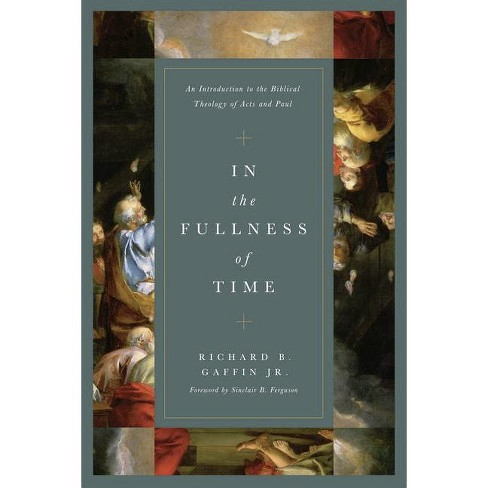
Ken Gentry Introduction
The following material is quoted from Richard B. Gaffin, In the Fullness of Time (ch. 10). It helpfully introduces the biblical concept of the two-age redemptive-history construct, including the overlap of those two ages in post-incarnation history. I highly recommend getting, reading, and studying this book as an excellent Reformed analysis of the structure of redemptive-history, which has Christ as its center-point. The book may be ordered at ChristianBooks.com
Conservative evangelical Christians who believe in the physical resurrection of Christ will find this valuable for understanding redemptive history from Christ’s first coming in the first century to his second coming at the end of history. Those who reject the historic, corporate, public, universal, systematic Christian faith’s commitment to the historic, physical resurrection of Christ and his continued incarnational existence in heaven (e.g., Col. 2:9) and his future, visible, glorious, physical second coming to call forth the resurrection of the death and establish the consummate new creation to replace the fallen original creation will probably just want to skip reading this material and move on to other things. In fact, my last sentence was so long, you may want to skip that too. I know I do!
So then, the following paragraphs are a direct citation from Gaffin’s chapter 10: “Eschatological Structure.”
RICHARD GAFFIN, IN THE FULLNESS OF TIME (ch. 10; pp. 245–247):
The center of Paul’s theology, as we have seen, is at the intersection of his teaching about Christ (Christology), his work (soteriology/redemption accomplished), and the redemptive-historical context of this saving work (eschatology). Any one of these three themes, then, may be made the vantage point for exploring the other two and so the hear of Paul’s theology, those things ‘of first importance” (1 Cor. 15:3). Here, as a preferable way of proceeding for my purposes, his Christology and soteriology will be considered in the light of his eschatology.
PAUL’S USE OF THE TWO-AGE DISTINCTION: BACKGROUND
Paul’s use of the distinction between ‘this age’ and ‘the age to come’ is perhaps the best way, certainly a helpful way, of showing the eschatological structure of his thinking and how it shapes his teaching.
The Origin of the Distinction between the Two Ages
This distinction first emerged in Second Temple Judaism during the inter-testamental period, where it functioned to facilitate reflecting on the overall historical-eschatological outlook of the Old Testament, especially the prophets. From there, it is take over by Jesus, Paul, and the writer of Hebrews.
On the one hand, this age is provisional and pre-eschatological. It is the time of the present world, originally ‘very good” (Gen. 1:31), but now subsequent to the fall, marked fundamentally by the presence of sin and its consequences — corruption and death. The age to come, in contrast, is the final world order for the creation, the eschatological age of righteousness, incorruption, perfection, and life. It is coterminous with the coming kingdom of God, the arrival of the day of the Lord, and the new heavens and new earth.
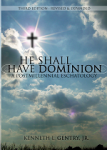
He Shall Have Dominion (paperback by Kenneth Gentry)
A classic, thorough explanation and defense of postmillennialism (600+ pages). Complete with several chapters answering specific objections.
See more study materials at: www.KennethGentry.com
The division point between the two ages — ‘the end of the age,” when this age ends and gives way to the age to come — is tied to the coming of the Messiah (in the New Testament, Matt. 24:3).
As used in the two-age construct, the word for “age” — in Hebrew olam, Aramaic eylam, and Greek (aion), and subsequently after the New Testament was written, in Latin (saeculum — took on as well the sense of “world” or “universe.”“ In other words, a comprehensive time word gained an all-inclusive spatial connotation. The distinction, then, expressed more fully, is between this world-age and the world-age to come, between the present world order and the coming world order.
In what follow here, when discussing the use of this distinction, I will often use aeon, a derivative of the Greek aion, interchangeably with age, its primary meaning, as a way of keeping view the “world-age” sense, the spatial as well as the inherently temporal sense of the contrast, and that the contrast is between two comprehensive spatiotemporal orders, one provisional and pre-eschatological, the other final and eschatological.
In sum, in their relationship, the two aeons are comprehensive (together they cover the entire flow of time, the whole of history, from its beginning t creation up to and including its consummation), consecutive (no other period intervenes between them) and antithetical (due to the entrance of sine with its effects into this age).
Modifications of the Two-Aeon Distinction
While the two-aeon construction was at hand I the Judaism contemporary to Jesus and the New Testament writers, they could not simply take it over unchanged. The reason is not difficult to see: for Judaism (as continues to be true for Orthodox Judaism today), the coming of the Messiah — the turning point of the two ages, the great inaugurating eschatological event — has not yet occurred; it is still future. However, for the New Testament and for Pau specifically, this decisive turn-of-the-ages event has already taken place; the Messiah has already come in the person and work of Jesus. While his coming does have a still-future component to it, the crucial eschatological event — the coming of the Christ marking the end of this age — has already taken place.
Consequently, for Paul, to continue using the two-aeon distinction as a basic structuring element in his theology, correspondingly fundamental modifications of the construct were necessary. These modifications with the changed patter that results are best spelled out after we survey and reflect on some pertinent passages. These are passages where Paul either makes explicit use of the distinction, or it is clearly in the background and shapes what he has to say.
[image error]For more information and to order click here." data-image-caption="" data-medium-file="https://postmillennialismtoday.files...." data-large-file="https://postmillennialismtoday.files...." src="https://postmillennialismtoday.files...." alt="Navigating the Book of Revelation: Special Studies on Important Issues" class="wp-image-209" />Navigating the Book of Revelation (by Ken Gentry)
Technical studies on key issues in Revelation, including the seven-sealed scroll, the cast out temple, Jewish persecution of Christianity, the Babylonian Harlot, and more.
See more study materials at: www.KennethGentry.com
END OF GAFFIN QUOTE
Ken Gentry note
In the material that follows, Dr. Gaffin ably presents and analyzing the following texts as important to the two-age structure of redemptive history; Galatians 1:4 (pp. 247–250); Ephesians 2:2 (pp. 250–251); Romans 12:2 (pp. 251–252); 1 Corinthians 1:18–3:23 (pp. 252–255); 2 Corinthians 5:17 (pp. 255–261); Romans 1:2 (p. 261); Romans 16:25–27 (pp. 261–264); Colossians 1:26–27 (pp. 264–267); Galatians 4:4, Ephesians 1:10, 1 Corinthians 10:11 (pp. 267–269); 2 Corinthians 6:2 (pp. 269–272); Galatians 3:23, 25 (pp. 272–276).
This book should be read along with the following:
Geerhardus Vos, The Pauline Eschatology (originally written in 1930, but in print still today.
John Murray, “Structural Strands in New Testament Eschatology,” (paper presented at ETS, December 29, 1954; available at http://www.kerux.com/doc/0603A2.asp)
Herman Ridderbos, Redemptive History and the New Testament Scriptures (originally written in 1955, but in print still today)
G. E. Ladd, The Presence of the Future (rev. ed.; Grand Rapids: Eerdmans, 2000 (originally written in 1974, and still available)
Kenneth L. Gentry Jr.'s Blog
- Kenneth L. Gentry Jr.'s profile
- 85 followers



